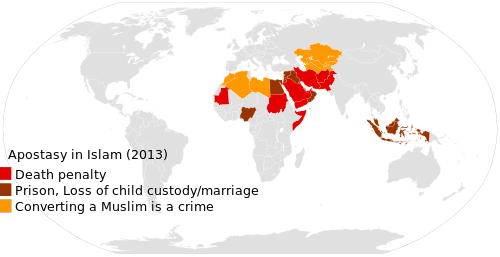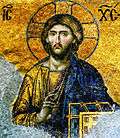Eastern Catholic Churches
| Part of a series on |
| Particular churches sui iuris of the Catholic Church |
|---|
| Latin, and Eastern Catholic traditions: |
| Latin |
| Byzantine Rite |
| Antiochian or West Syrian |
| East Syrian Rite |
| Armenian |
| Alexandrian |
|
|
The Eastern Catholic Churches, also historically known as the Eastern-rite Catholic Churches or Uniate Churches,[lower-alpha 1] are 23 Eastern Christian particular churches sui iuris in full communion with the Pope in Rome, which make up the Catholic Church together with the Latin Church.
Headed by patriarchs, metropolitans, and major archbishops, the Eastern Catholic Churches are governed in accordance with the Code of Canons of the Eastern Churches, although each church also has its own canons and laws on top of this, and the preservation of their own traditions is explicitly encouraged. The total membership of the various churches accounts for about 16 million, according to the Annuario Pontificio, thus making up a small part of the Catholic Church, with rest of its more than 1.2 billion members belonging to the Latin Church.

While the Maronite Church is considered the sole of them to permanently have remained in full communion with the Holy See, most of the other churches unified at some point from the 16th century onwards. The most recent of the Eastern Catholic Churches is the Eritrean Catholic Church, which was unified in 2015.
Full communion constitutes mutual sacramental sharing between the Eastern Catholic Churches and the Latin Church, including Eucharistic intercommunion. On the other hand, the liturgical traditions of the 23 Eastern Catholic churches, including Byzantine, Alexandrian, Armenian, East Syrian, and West Syrian, are shared with other Eastern Christian churches: the Eastern Orthodox, Oriental Orthodox, and the Church of the East. Although some theological issues divide the Eastern Catholic churches from other Eastern Christian churches, they do admit members of the latter to the Eucharist and the other sacraments, as governed by Oriental canon law.[lower-alpha 2]
Notably, Eastern Catholic churches have different traditions concerning clerical celibacy than the Latin Church: in general, Eastern Catholic Churches allow the ordination of married men as priests.
Eastern Catholic churches have their origins in the Middle East, East Africa, Eastern Europe and India. However, since the 19th century, they have spread to Western Europe, the Americas and Oceania by emigration partly because of persecution, where eparchies have been established to serve adherents alongside those of Latin Church dioceses. Latin Catholics in the Middle East, on the other hand, are traditionally served by the Latin Patriarchate of Jerusalem.
.jpg)
Terminology
Although Eastern Catholics are in full communion with the Pope and members of the worldwide Catholic Church,[lower-alpha 3][lower-alpha 4] they are not members of the Latin Church, which uses the Latin liturgical rites, among which the Roman Rite is the most widespread.[lower-alpha 5] The Eastern Catholic churches are instead distinct particular churches sui iuris, although maintain full and equal, mutual sacramental exchange with members of the Latin Church.
Rite or church
There are different meanings of the word rite. Apart from its reference to the liturgical patrimony of a particular church, the word has been and is still sometimes, even if rarely, officially used of the particular church itself. Thus the term Latin rite can refer either to the Latin Church or to one or more of the Western liturgical rites, which include the majority Roman Rite but also the Ambrosian Rite, the Mozarabic Rite, and others.
In the 1990 Code of Canons of the Eastern Churches (CCEO),[5][6] the terms autonomous Church and rite are thus defined:
A group of Christian faithful linked in accordance with the law by a hierarchy and expressly or tacitly recognized by the supreme authority of the Church as autonomous is in this Code called an autonomous Church (canon 27).[7]
- A rite is the liturgical, theological, spiritual and disciplinary patrimony, culture and circumstances of history of a distinct people, by which its own manner of living the faith is manifested in each autonomous [sui iuris] Church.
- The rites treated in CCEO, unless otherwise stated, are those that arise from the Alexandrian, Antiochene, Armenian, Chaldean and Constantinopolitan traditions" (canon 28)[8] (not just a liturgical heritage, but also a theological, spiritual and disciplinary heritage characteristic of peoples' culture and the circumstances of their history).
When speaking of Eastern Catholic Churches, the Latin Church's 1983 Code of Canon Law (1983 CIC) uses the terms "ritual Church" or "ritual Church sui iuris" (canons 111 and 112), and also speaks of "a subject of an Eastern rite" (canon 1015 §2), "Ordinaries of another rite" (canon 450 §1), "the faithful of a specific rite" (canon 476), etc. The Second Vatican Council spoke of Eastern Catholic Churches as "particular Churches or rites".[9](n. 2)
In 1999, the United States National Conference of Catholic Bishops stated: "We have been accustomed to speaking of the Latin (Roman or Western) Rite or the Eastern Rites to designate these different Churches. However, the Church's contemporary legislation as contained in the Code of Canon Law and the Code of Canons of the Eastern Churches makes it clear that we ought to speak, not of rites, but of Churches. Canon 112 of the Code of Canon Law uses the phrase 'autonomous ritual Churches' to designate the various Churches."[10] And a writer in a periodical of January 2006 declared: "The Eastern Churches are still mistakenly called 'Eastern-rite' Churches, a reference to their various liturgical histories. They are most properly called Eastern Churches, or Eastern Catholic Churches."[11] However, the term "rite" continues to be used. The 1983 CIC forbids a Latin bishop to ordain, without permission of the Holy See, a subject of his who is "of an Eastern rite" (not "who uses an Eastern rite", the faculty for which is sometimes granted to Latin clergy).[12] Pope Benedict XVI wrote, in his 2007 motu proprio Summorum Pontificum, that "any Catholic priest of the Latin rite",[lower-alpha 6] under certain conditions, "may use either" edition of the Roman Missal.[14]
Uniate
The term Uniat or Uniate applies to Eastern Catholic churches previously part of Eastern or Oriental Orthodox churches or of the Assyrian Church of the East. The term is sometimes considered to have a derogatory connotation,[15][16] though it was occasionally used by Latin and Eastern Catholics prior to the Second Vatican Council.[lower-alpha 7] Official Catholic documents no longer use the term due to its perceived negative overtones.[16] According to John Erickson of Saint Vladimir's Orthodox Theological Seminary, "The term 'uniate' itself, once used with pride in the Roman communion, had long since come to be considered as pejorative. 'Eastern Rite Catholic' also was no longer in vogue because it might suggest that the Catholics in question differed from Latins only in the externals of worship. The Second Vatican Council affirmed rather that Eastern Catholics constituted churches whose vocation was to provide a bridge to the separated churches of the East."[19]
History
Background
Communion between Christian churches has been broken over matters of faith, whereby each side accused the other of heresy or departure from the true faith (orthodoxy). Communion has been broken also because of disagreement about questions of authority or the legitimacy of the election of a particular bishop. In these latter cases each side accused the other of schism, but not of heresy.
Major breaches of communion:
Council of Ephesus (431 AD)
In 431 the Churches that accepted the teaching of the Council of Ephesus (which condemned the views of Nestorius) classified as heretics those who rejected the Council's statements. The Church of the East, which was mainly under the Sassanid Empire, never accepted the council's views. It later experienced a period of great expansion in Asia before collapsing after the Mongol invasion of the Middle East in the 14th century.
Monuments of their presence still exist in China. Now they are relatively few in numbers and are divided into Four Churches, of which the Chaldaean Church, which is in communion with Rome, is the largest, while the territory in India become under the direct jurisdiction of Pope. Later it got autonomy to form Syro Malabar Church and others have recently split between the Assyrian Church of the East and the Ancient Church of the East.
Council of Chalcedon (451 AD)
In 451 those who accepted the Council of Chalcedon similarly classified those who rejected it as Monophysite heretics. The Churches that refused to accept the Council considered instead that it was they who were orthodox; they reject the description Monophysite preferring instead Miaphysite. They are often called, in English, Oriental Orthodox Churches, to distinguish them from the Eastern Orthodox Churches.
This distinction, by which the words oriental and eastern that in themselves have exactly the same meaning but are used as labels to describe two different realities, is impossible to translate in most other languages, and is not universally accepted even in English. These churches are also referred to as pre-Chalcedonian or now more rarely as non-Chalcedonian or anti-Chalcedonian. In languages other than English other means are used to distinguish the two families of Churches. Some reserve the term "Orthodox" for those that are here called "Eastern Orthodox" Churches, but members of what are called "Oriental/Eastern Orthodox" Churches consider this illicit.
East–West Schism (1054)
The East–West Schism came about in the context of cultural differences between the Greek-speaking East and Latin-speaking West and of rivalry between the Churches in Rome, which claimed a primacy not merely of honour but also of authority—and in Constantinople, which claimed parity with Rome.[20] The rivalry and lack of comprehension gave rise to controversies, some of which appear already in the acts of the Quinisext Council of 692. At the Council of Florence (1431–1445), these controversies about Western theological elaborations and usages were identified as, chiefly, the insertion of "Filioque" into the Nicene Creed, the use of unleavened bread for the Eucharist, Purgatory, and the authority of the Pope.[lower-alpha 8]
The schism is conventionally dated as occurring at 1054, when the Patriarch of Constantinople, Michael I Cerularius, and the Papal Legate, Humbert of Silva Candida, issued mutual excommunications. (In 1965 these excommunications were revoked by both Rome and Constantinople.) In spite of that event, for many years both Churches continued to maintain friendly relations and seemed to be unaware of any formal or final rupture.[22]
However, estrangement continued to grow. In 1190, Eastern Orthodox theologian Theodore Balsamon who was patriarch of Antioch, wrote that "no Latin should be given Communion unless he first declares that he will abstain from the doctrines and customs that separate him from us".[23]
Later, Constantinople was sacked in 1204 by the Catholic armies of the Fourth Crusade, whereas two decades previously the Massacre of the Latins (i.e. Catholics) had occurred in Constantinople in 1182. Thus, by the 12th–13th centuries, the two sides had become openly hostile, each considering that the other no longer belonged to the Church that was orthodox and catholic. Over time, it became customary to refer to the Eastern side as the Orthodox Church and the Western as the Catholic Church, without either side thereby renouncing its claim to be the truly orthodox or the truly catholic Church.
Attempts at restoring communion
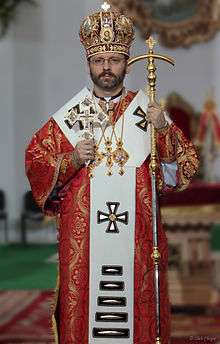
Within each Church, no longer in communion with the Church of Rome, there arose a group that considered it important to restore that communion. In 1438, the Council of Florence convened, which featured a strong dialogue focused on understanding the theological differences between the East and West, with the hope of reuniting the Catholic and Orthodox churches.[24] Several eastern churches associated themselves with Rome, forming Eastern Catholic Churches. The See of Rome accepted them without requiring that they adopt the customs of the Latin Church, so that they all have their own "liturgical, theological, spiritual and disciplinary heritage, differentiated by peoples' culture and historical circumstances, that finds expression in each sui iuris Church's own way of living the faith".[25]
In 1993 the Joint International Commission for Theological Dialogue Between the Catholic Church and the Orthodox Church submitted the document Uniatism, method of union of the past, and the present search for full communion, also known as the Balamand declaration, "to the authorities of the Catholic and Orthodox Churches for approval and application,"[26] which stated that initiatives that "led to the union of certain communities with the See of Rome and brought with them, as a consequence, the breaking of communion with their Mother Churches of the East ... took place not without the interference of extra-ecclesial interests".[26](n. 8)
Likewise the commission acknowledged that "certain civil authorities [who] made attempts" to force Eastern Catholics to return to the Orthodox Church used "unacceptable means".[26](n. 11) The missionary outlook and proselytism that accompanied the Unia[26](n. 10) was judged incompatible with the rediscovery by the Catholic and Orthodox Churches of each other as Sister Churches.[26](n. 12) Thus the commission concluded that the "missionary apostolate ..., which has been called 'uniatism', can no longer be accepted either as a method to be followed or as a model of the unity our Churches are seeking."[26](n. 12)
At the same time, the Commission stated:
- that Eastern Catholic Churches, being part of the Catholic Communion, have the right to exist and to act in response to the spiritual needs of their faithful[26](n. 3)
- that Oriental Catholic Churches, which desired to re-establish full communion with the See of Rome and have remained faithful to it, have the rights and obligations connected with this communion[26](n. 16)
Emergence of Eastern Catholic churches

Most Eastern Catholic churches arose when a group within an ancient church in disagreement with the See of Rome returned to full communion with that see. The following Churches have been in communion with the Bishop of Rome for a large part of their history:
- The Maronite Church, which has no counterpart in Byzantine, nor Oriental, Orthodoxy. The Maronite Church has historical connections to the Monothelite controversy in the 7th century. It affirmed unity with the Holy See in 1181 during the Crusades.
- The Italo-Albanian Catholic Church, unlike the Maronite Church, uses the same liturgical rite as the Eastern Orthodox Church.
The canon law shared by all Eastern Catholic churches, CCEO, was codified in 1990. The dicastery that works with the Eastern Catholic churches is the Congregation for the Oriental Churches which, by law, includes as members all Eastern Catholic patriarchs and major archbishops.
Orientalium dignitas

On 30 November 1894 Pope Leo XIII issued the apostolic constitution Orientalium dignitas in which he stated:
The Churches of the East are worthy of the glory and reverence that they hold throughout the whole of Christendom in virtue of those extremely ancient, singular memorials that they have bequeathed to us. For it was in that part of the world that the first actions for the redemption of the human race began, in accord with the all-kind plan of God. They swiftly gave forth their yield: there flowered in first blush the glories of preaching the True Faith to the nations, of martyrdom, and of holiness. They gave us the first joys of the fruits of salvation. From them has come a wondrously grand and powerful flood of benefits upon the other peoples of the world, no matter how far-flung. When blessed Peter, the Prince of the Apostles, intended to cast down the manifold wickedness of error and vice, in accord with the will of Heaven, he brought the light of divine Truth, the Gospel of peace, freedom in Christ to the metropolis of the Gentiles.[27]
Adrian Fortescue wrote that Leo XIII "begins by explaining again that the ancient Eastern rites are a witness to the Apostolicity of the Catholic Church, that their diversity, consistent with unity of the faith, is itself a witness to the unity of the Church, that they add to her dignity and honour. He says that the Catholic Church does not possess one rite only, but that she embraces all the ancient rites of Christendom; her unity consists not in a mechanical uniformity of all her parts, but on the contrary, in their variety, according in one principle and vivified by it."[28]
Leo XIII declared still in force Pope Benedict XIV's encyclical Demandatam, addressed to the Patriarch and the Bishops of the Melkite Catholic Church, in which Benedict XIV forbade Latin Rite clergy to induce Melkite Catholics to transfer to the Latin rite, and he broadened this prohibition to cover all Eastern Catholics, declaring: "Any Latin rite missionary, whether of the secular or religious clergy, who induces with his advice or assistance any Eastern rite faithful to transfer to the Latin rite, will be deposed and excluded from his benefice in addition to the ipso facto suspension a divinis and other punishments that he will incur as imposed in the aforesaid Constitution Demandatam."[27]
Second Vatican Council

There had been confusion on the part of Western clergy about the legitimate presence of Eastern Catholic Churches in countries seen as belonging to the West, despite firm and repeated papal confirmation of these Churches' universal character. The Second Vatican Council brought the reform impulse to visible fruition. Several documents, from both during and after the Second Vatican Council, have led to significant reform and development within Eastern Catholic Churches.
Orientalium Ecclesiarum
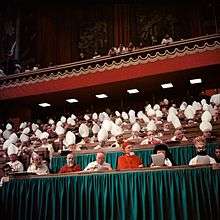
The Second Vatican Council directed, in Orientalium Ecclesiarum, that the traditions of Eastern Catholic Churches should be maintained. It declared that "it is the mind of the Catholic Church that each individual Church or Rite should retain its traditions whole and entire and likewise that it should adapt its way of life to the different needs of time and place" (n. 2), and that they should all "preserve their legitimate liturgical rite and their established way of life, and ... these may not be altered except to obtain for themselves an organic improvement" (n. 6; cf. n. 22).[9]
It confirmed and approved the ancient discipline of the sacraments existing in the Eastern churches, and the ritual practices connected with their celebration and administration, and declared its ardent desire that this should be re-established, if circumstances warranted (n. 12). It applied this in particular to administration of sacrament of Confirmation by priests (n. 13). It expressed the wish that, where the permanent diaconate (ordination as deacons of men who are not intended afterwards to become priests) had fallen into disuse, it should be restored (n. 17).
Paragraphs 7–11 are devoted to the powers of the patriarchs and major archbishops of the Eastern Churches, whose rights and privileges, it says, should be re-established in accordance with the ancient tradition of each of the Churches and the decrees of the ecumenical councils, adapted somewhat to modern conditions. Where there is need, new patriarchates should be established either by an ecumenical council or by the Bishop of Rome.
Lumen gentium
The Second Vatican Council's Dogmatic Constitution on the Church, Lumen gentium, deals with Eastern Catholic Churches in paragraph 23, stating:
By divine Providence it has come about that various churches, established in various places by the apostles and their successors, have in the course of time coalesced into several groups, organically united, which, preserving the unity of faith and the unique divine constitution of the universal Church, enjoy their own discipline, their own liturgical usage, and their own theological and spiritual heritage. Some of these churches, notably the ancient patriarchal churches, as parent-stocks of the Faith, so to speak, have begotten others as daughter churches, with which they are connected down to our own time by a close bond of charity in their sacramental life and in their mutual respect for their rights and duties. This variety of local churches with one common aspiration is splendid evidence of the catholicity of the undivided Church. In like manner the Episcopal bodies of today are in a position to render a manifold and fruitful assistance, so that this collegiate feeling may be put into practical application.[29]
Unitatis Redintegratio
The 1964 decree Unitatis Redintegratio deals with Eastern Catholic Churches in paragraphs 14–17.[30]
Code of Canons of the Eastern Churches
The First Vatican Council discussed the need for a common code for the Eastern Churches, but no concrete action was taken. Only after the benefits of the Latin Church's 1917 Code of Canon Law were appreciated was a serious effort made to codify Eastern Catholic Churches canon laws.[31](p27) This came to fruition with the promulgation of the 1990 Code of Canons of the Eastern Churches, which took effect in 1991. It is a framework document that contains canons that are a consequence of the common patrimony of the Churches of the East: each individual sui iuris Church also has its own canons, its own particular law, layered on top of this code.
Liturgical prescriptions
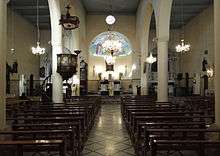
The 1996 Instruction for Applying the Liturgical Prescriptions of the Code of Canons of the Eastern Churches brought together, in one place, the developments that took place in previous texts,[32] and is "an expository expansion based upon the canons, with constant emphasis upon the preservation of Eastern liturgical traditions and a return to those usages whenever possible—certainly in preference to the usages of the Latin Church, however much some principles and norms of the conciliar constitution on the Roman rite, 'in the very nature of things, affect other rites as well'."[31](p998) The Instruction states:
The liturgical laws valid for all the Eastern Churches are important because they provide the general orientation. However, being distributed among various texts, they risk remaining ignored, poorly coordinated and poorly interpreted. It seemed opportune, therefore, to gather them in a systematic whole, completing them with further clarification: thus, the intent of the Instruction, presented to the Eastern Churches which are in full communion with the Apostolic See, is to help them fully realize their own identity. The authoritative general directive of this Instruction, formulated to be implemented in Eastern celebrations and liturgical life, articulates itself in propositions of a juridical-pastoral nature, constantly taking initiative from a theological perspective.[32](n. 5)
Past interventions by the Holy See, the Instruction said, were in some ways defective and needed revision, but often served also as a safeguard against aggressive initiatives.
These interventions felt the effects of the mentality and convictions of the times, according to which a certain subordination of the non-Latin liturgies was perceived toward the Latin-rite liturgy which was considered "ritus praestantior".[lower-alpha 9] This attitude may have led to interventions in the Eastern liturgical texts which today, in light of theological studies and progress, have need of revision, in the sense of a return to ancestral traditions. The work of the commissions, nevertheless, availing themselves of the best experts of the times, succeeded in safeguarding a major part of the Eastern heritage, often defending it against aggressive initiatives and publishing precious editions of liturgical texts for numerous Eastern Churches. Today, particularly after the solemn declarations of the Apostolic Letter Orientalium dignitas by Leo XIII, after the creation of the still active special Commission for the liturgy within the Congregation for the Eastern Churches in 1931, and above all after the Second Vatican Council and the Apostolic Letter Orientale Lumen by John Paul II, respect for the Eastern liturgies is an indisputable attitude and the Apostolic See can offer a more complete service to the Churches.[32](n. 24)
Organisation
Papal supreme authority
Under the Code of Canons of the Eastern Churches, the Pope has supreme, full, immediate and universal ordinary authority in the whole Catholic Church, which he can always freely exercise, including the Eastern Catholic churches,[33][lower-alpha 10] and their leaders.[35]
Eastern patriarchs and major archbishops
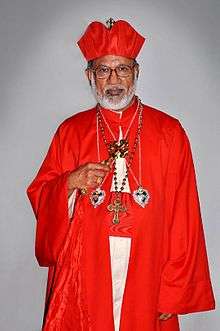
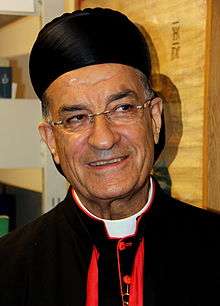
The Catholic patriarchs and major archbishops derive their titles from the sees of Alexandria (Coptic), Antioch (Syriac, Melkite, Maronite), Babylonia (Chaldaean), Cilicia (Armenian), Kiev-Halych (Ukrainian), Ernakulam-Angamaly (Syro-Malabar), Thiruvananthapuram (Syro-Malankara), and Făgăraş-Alba Iulia (Romanian). The Eastern Catholic churches are governed in accordance with CCEO.[35]
Within their proper sui iuris churches there is no difference between patriarchs and major archbishops. However, differences exist in the order of precedence (i.e. patriarchs take precedence over major archbishops) and in the mode of accession: The election of major archbishops has to be confirmed by the pope before allowed to take office.[36] No papal confirmation is needed for newly elected patriarchs before they take office. They are just required to inquire the pope as soon as possible to grant them full ecclesiastical communion.[37][lower-alpha 11]
Juridical status
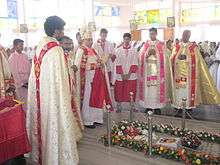
Although every diocese in the Catholic Church is considered a particular church, the word is not applied in the same sense as to the 24 sui iuris particular churches: the Latin Church and the 23 Eastern Catholic Churches.
Canonically, each Eastern Catholic Church is sui iuris or autonomous with respect to other Catholic churches, whether Latin or Eastern, though all accept the spiritual and juridical supreme authority of the pope. Thus a Maronite Catholic is normally directly subject only to a Maronite bishop. However, if members of a particular church are so few that no hierarchy of their own has been established, their spiritual care is entrusted to a bishop of another ritual church. For instance, members of the Latin Church in Eritrea are under the care of the Eastern rite Eritrean Catholic Church, whereas the other way around may be the case in other parts of the world.
Theologically, all the particular churches can be viewed as "sister churches".[39] According to the Second Vatican Council these Eastern Catholic churches, along with the larger Latin Church, share "equal dignity, so that none of them is superior to the others as regards rite, and they enjoy the same rights and are under the same obligations, also in respect of preaching the Gospel to the whole world (cf. Mark 16:15) under the guidance of the Roman Pontiff."[9](n. 3)

The Eastern Catholic churches are in full communion with the whole Catholic Church. While they accept the canonical authority of the Holy See of Rome, they retain their distinctive liturgical rites, laws, customs and traditional devotions, and have their own theological emphases. Terminology may vary: for instance, diocese and eparchy, vicar general and protosyncellus, confirmation and chrismation are respectively Western and Eastern terms for the same realities. The mysteries (sacraments) of baptism and chrismation are generally administered, according to the ancient tradition of the church, one immediately after the other. Infants who are baptized and chrismated are also given the Eucharist.[40]
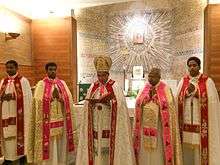
The Eastern Catholic churches are represented in the Holy See and the Roman Curia through the Congregation for the Oriental Churches, which is "made up of a Cardinal Prefect (who directs and represents it with the help of a Secretary) and 27 cardinals, one archbishop and 4 bishops, designated by the pope ad quinquennium (for a five-year period). Members by right are the Patriarchs and the Major Archbishops of the Oriental Churches and the President of the Pontifical Council for the Promotion of Unity among Christians."[41]
Totalling about 16 million members, the greatest numbers of Eastern Catholics may be found in Eastern Europe (Ukraine, Romania, Slovakia), Eastern Africa and the Middle East (Egypt, Iraq, Lebanon, Syria) and India.
Bi-ritual faculties

While "clerics and members of institutes of consecrated life are bound to observe their own rite faithfully,"[42] priests are occasionally given permission to celebrate the liturgy of a rite other than the priest's own rite, by what is known as a grant of "biritual faculties". The reason for this permission is usually the service of Catholics who have no priest of their own rite. Thus priests of the Syro-Malabar Church working as missionaries in areas of India in which there are no structures of their own Church, are authorized to use the Roman Rite in those areas, and Latin-Rite priests are, after due preparation, given permission to use an Eastern rite for the service of members of an Eastern Catholic Church living in a country in which there are no priests of their own particular Church. Popes are permitted to celebrate a Mass or Divine Liturgy of any rite in testament to the Catholic Church's universal nature. John Paul II celebrated the Divine Liturgy in Ukraine during his pontificate.
For a just cause, and with the permission of the local bishop, priests of different autonomous ritual Churches may concelebrate; however, the rite of the principal celebrant is used whilst each priest wears the vestments of his own rite.[43] No indult of bi-ritualism is required for this.
Biritual faculties may concern not only clergy but also religious, enabling them to become members of an institute of an autonomous Church other than their own.[44]
The laity is typically encouraged to foster an appreciation of their own rite, and is invited to observe that rite unless there is good reason, e.g. a Latin-Rite Catholics living in an exclusively Ethiopian Rite country.[45] This does not forbid occasional or even, for a just cause, habitual participation in the liturgy of a different autonomous Church, Western or Eastern. The obligation of assisting at the Eucharist or, for members of some Eastern Churches, at Vespers, is satisfied wherever the liturgy is celebrated in a Catholic rite.[46]
Clerical celibacy
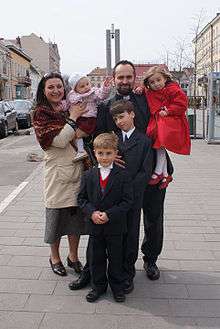
Eastern and Western Christian churches have different traditions concerning clerical celibacy and the resulting controversies have played a role in the relationship between the two groups in some Western countries.
In general, Eastern Catholic Churches allow ordination of married men as priests. Within the lands of the Ukrainian Greek Catholic Church, the largest Eastern Catholic Church, priests' children often became priests and married within their social group, establishing a tightly-knit hereditary caste.[47]
Most Eastern Churches distinguish between "monastic" and "non-monastic" clergy. Monastics do not necessarily live as monks or in monasteries, but have spent at least part of their period of training in such a context. Their monastic vows include a vow of celibate chastity.
Bishops are normally selected from the monastic clergy, and in most Eastern Catholic Churches a large percentage of priests and deacons also are celibate, while a large portion of the clergy (typically, parish priests) are married, having taken a wife when they were still laymen.[47] If someone preparing for the diaconate or priesthood wishes to marry, this must happen before ordination.
In territories where Eastern traditions prevail, married clergy caused little controversy, but aroused opposition inside traditionally Latin Church territories to which Eastern Catholics migrated; this was particularly so in the United States. In response to requests from the Latin bishops of those countries, the Congregation for the Propagation of the Faith set out rules in an 1890 letter to François-Marie-Benjamin Richard, archbishop of Paris,[48] which the Congregation applied on 1 May 1897 to the United States,[49] stating that only celibates or widowed priests coming without their children should be permitted in the United States.
This celibacy mandate for Eastern Catholic priests in the United States was restated with special reference to Catholics of Ruthenian Rite by the 1 March 1929 decree Cum data fuerit, which was renewed for a further ten years in 1939. Dissatisfaction by many Ruthenian Catholics in the United States gave rise to the American Carpatho-Russian Orthodox Diocese.[50] The mandate, which applied in some other countries also, was removed by a decree of June 2014.[51]
While most Eastern Catholic Churches admit married men to ordination as priests, though not allowing priests, after ordination, to marry, some have adopted mandatory clerical celibacy, as in the Latin Church. These include the India-based Syro-Malankara Catholic Church and Syro-Malabar Catholic Church,[52][53] and the Coptic Catholic Church.[54]
In 2014, Pope Francis approved new norms for married clergy within Eastern Catholic Churches through CCEO canon 758 § 3. The new norms abrogated previous norms and now allow ordination of married clergy by all Eastern Catholic Churches, except the Syro-Malabar and Syro-Malankara Catholic Churches, inside traditionally Latin Church territories, and allow Eastern Catholic Churches to grant faculties inside traditionally Latin Church territories to married clergy previously ordained by Eastern Catholic Churches elsewhere.[55] "This means they will be able to follow their faithful to whichever country they immigrate to."[56]
List of Eastern Catholic churches
The Holy See's Annuario Pontificio gives the following list of Eastern Catholic churches with the principal see of each and the countries (or larger political areas) where they have ecclesiastical jurisdiction, to which are here added the date of union or foundation in parenthesis and the membership in brackets. The total membership is about 16,336,000. (Eternal Word Television Network (EWTN) gives the same list, except that it does not place the liturgical traditions in the alphabetical order in which they are given by both the Annuario Pontificio and CCEO canon 28 and, as noted below, it treats the Apostolic Exarchate for Byzantine-Rite Catholics in the Czech Republic, which for the Holy See is part of the Ruthenian Catholic Church, as if it were a separate autonomous church.).[57]
Membership
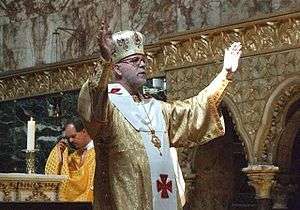
Eastern Catholic Churches make up a small percentage of the membership in the Catholic Church when compared to the Latin Church, which has over 1,2 billion members. The 2008 statistics collected by the Catholic Near East Welfare Association (CNEWA) show that Syriac Christians make up 47% of Eastern Catholics and Byzantine Christians make up 46%. More recent statistics show that the three largest Eastern churches are the Byzantine Ukrainian Greek Catholic Church with 5.3 million members[62] (in 2008, 25% of all Eastern Catholics), the Syriac Syro-Malabar Catholic Church at 4.6 million faithful[63] (in 2008, 23%), and the Maronite Catholic Church with 3.29 million adherents (20%).[64]
Other
Georgian Byzantine-Rite Catholics are not recognized as a particular Church.[lower-alpha 12] The majority of Eastern Catholic Christians in the Georgian Republic worship under the form of the Armenian liturgical rite.
The list shows that an individual autonomous particular Church may have distinct jurisdictions (local particular Churches) in several countries.
The Ruthenian Catholic Church is organized in an exceptional way because of a constituent metropolia: the Byzantine Catholic Metropolitan Church of Pittsburgh is also, unofficially, referred to as the Byzantine Catholic Church in America. Canon law treats it as if it held the rank of an autonomous (sui iuris) metropolitan particular church because of the circumstances surrounding its 1969 establishment as an ecclesiastical province. At that time, conditions in the Rusyn homeland, known as Carpatho-Rus, admitted no other solution because the Byzantine Catholic Church had been forcibly suppressed by the Soviet authorities. When Communist rule ended, the Byzantine Catholic Eparchy of Mukacheve (founded in 1771) re-emerged. It has some 320,000 adherents, greater than the number in the Pittsburgh metropolia. In addition, an apostolic exarchate established in 1996 for Catholics of Byzantine rite in the Czech Republic is classed as another part of the Ruthenian Catholic Church.
On the EWTN website the Apostolic Exarchate for Byzantine-rite Catholics in the Czech Republic is mentioned in a list of Eastern Churches, of which all the rest are autonomous particular churches.[57] This is a mistake, since recognition within the Catholic Church of the autonomous status of a particular church can only be granted by the Holy See,[lower-alpha 12] which instead classifies this church as one of the constituent local particular churches of the autonomous (sui iuris) Ruthenian Catholic Church.
Some have treated Byzantine Rite Catholics within the Catholic Church in Georgia as a separate particular church with a reunion date of either 1861 or 1917.
Persecution
Islamic world
Christians have faced increasing levels of persecution in the Muslim world. Muslim nations in which Christian populations have suffered acute discrimination, persecution and in some cases death include; Iraq, Iran, Syria, Pakistan, Bangladesh, Afghanistan, Palestinian Territories, Egypt, Saudi Arabia, Turkey, Libya, Yemen, Sudan, Somalia, Qatar, Uzbekistan, Tunisia, Jordan, Oman, Algeria, Mali, Kuwait, Lebanon, Morocco, Indonesia, Malaysia, Niger, Tanzania, Kazakhstan, Tadjikistan, Turkmenistan, Kirghizstan, Mauritania, Eritrea, Bahrain, Comoros, Djibouti, Brunei, Tanzania, Maldives, Kenya, Gambia, Chad, United Arab Emirates, Kosovo, Chechnya, and Muslim majority areas of Nigeria and India.[67][68][69]
Furthermore, any Muslim person—including any person born to a Muslim family or having become Muslim at a given point in life—who converts to Christianity is considered to have performed apostasy. Apostasy, the conscious abandonment of Islam by a Muslim in word or through deed, including also conversion to Christianity, is punishable as a crime under applications of the Sharia (countries in the graph). There are, however, cases in which a Muslim will adopt the Christian faith, secretly without declaring his/her apostasy. As a result, they are practising Christians, but legally Muslims, and would face the death penalty. Meriam Ibrahim, a Sudanese woman, was sentenced to death for apostasy in 2014, because the government of Sudan classified her as a Muslim, while she was raised Christian.[70]
Eastern Europe
A study by Methodios Stadnik states: "The Georgian Byzantine Catholic Exarch, Fr. Shio Batmanishviii [sic], and two Georgian Catholic priests of the Latin Church were executed by the Soviet authorities in 1937 after having been held in captivity in Solovki prison and the northern gulags from 1923."[71] Christopher Zugger writes, in The Forgotten: "By 1936, the Byzantine Catholic Church of Georgia had two communities, served by a bishop and four priests, with 8,000 believers", and he identifies the bishop as Shio Batmalashvili.[72] Vasyl Ovsiyenko mentions, on the Ukrainian Helsinki Human Rights Union website, that "the Catholic administrator for Georgia Shio Batmalashvili" was one of those executed as "anti-Soviet elements" in 1937.[73]
Zugger calls Batmalashvili a bishop; Stadnik is ambiguous, calling him an exarch but giving him the title of Father; Ovsiyenko merely refers to him as "the Catholic administrator" without specifying whether he was a bishop or a priest and whether he was in charge of a Latin or a Byzantine jurisdiction.
If Batmalashvili was an exarch, and not instead a bishop connected with the Latin diocese of Tiraspol, which had its seat at Saratov on the Volga River, to which Georgian Catholics even of Byzantine rite belonged [74] this would mean that a Georgian Byzantine-Rite Catholic Church existed, even if only as a local particular Church. However, since the establishment of a new hierarchical jurisdiction must be published in Acta Apostolicae Sedis, and no mention of the setting up of such a jurisdiction for Byzantine Georgian Catholics exists in that official gazette of the Holy See, the claim appears to be unfounded.
The 1930s editions of Annuario Pontificio do not mention Batmalashvili. If indeed he was a bishop, he may then have been one of those secretly ordained for the service of the Church in the Soviet Union by French Jesuit Bishop Michel d'Herbigny, who was president of the Pontifical Commission for Russia from 1925 to 1934. In the circumstances of that time, the Holy See would have been incapable of setting up a new Byzantine exarchate within the Soviet Union, since Byzantine Catholics in the Soviet Union were being forced to join the Russian Orthodox Church.
Batmalashvili's name is not among those given in as the four "underground" apostolic administrators (only one of whom appears to have been a bishop) for the four sections into which the diocese of Tiraspol was divided after the resignation in 1930 of its already exiled last bishop, Josef Alois Kessler.[75] This source gives Father Stefan Demurow as apostolic administrator of "Tbilisi and Georgia" and says he was executed in 1938. Other sources associate Demurow with Azerbaijan and say that, rather than being executed, he died in a Siberian Gulag.[76]
Until 1994, the United States annual publication Catholic Almanac listed "Georgian" among the Byzantine churches.[77] Until corrected in 1995, it appears to have been making a mistake similar to that made on the equally unofficial EWTN site about the Czech Byzantine Catholics.
There was a short-lived Byzantine Catholic movement among the ethnic Estonians in the Orthodox Church in Estonia during the interwar period of the 20th century, consisting of two to three parishes, not raised to the level of a local particular church with its own head. This group was liquidated by the Soviet regime and is now extinct.
See also
Notes
- ↑ Due to severe pejorative connotations that came to be associated with this term, it has fallen out of polite use.
- ↑ "Catholic ministers licitly administer the sacraments of penance, Eucharist, and anointing of the sick to members of Eastern churches which do not have full communion with the Catholic Church if they seek such on their own accord and are properly disposed. This is also valid for members of other Churches which in the judgment of the Apostolic See have the same beliefs in regard to the sacraments as these Eastern Churches"[1]
- ↑ "The Catholic Church is also called the Roman Church to emphasize that the centre of unity, which is an essential for the Universal Church, is the Roman See"[2]
- ↑ Examples of the use of "Roman Catholic Church" by Popes, even when not addressing members of non-Catholic churches, are the encyclicals Divini illius Magistri and Humani generis, and Pope John Paul II's address at the 26 June 1985 general audience, in which he treated "Roman Catholic Church" as synonymous with "Catholic Church".[3] The term "Roman Catholic Church" is repeatedly used to refer to the whole Church in communion with the see of Rome, including Eastern Catholics, in official documents concerning dialogue between the Church as a whole (not just the Western part) and groups outside her fold. Examples of such documents can be found at the links on the Vatican website under the heading Pontifical Council for Promoting Christian Unity. The Holy See never uses "Roman Catholic Church" to refer only to the Western or Latin Church. In the First Vatican Council's Dogmatic Constitution de fide catholica, the phrase the Holy, Catholic, Apostolic, and Roman Church (Sancta catholica apostolica Romana ecclesia) also refers to something other than the Latin-Rite or Western Church.
- ↑ Some Eastern Catholics who use the Byzantine liturgical rite and call themselves "Byzantine Catholics" deny that they are "Roman Catholics", using this word to mean either Catholics who use the Roman Rite or perhaps the whole Latin Church, including those parts that use the Ambrosian Rite or other non-Roman liturgical rites: "We're Byzantine rite, which is Catholic, but not Roman Catholic" [4]
- ↑ Benedict XVI clarified his intent, in a parallel apostolic letter, which did not use "Latin rite" but used form or "usage of the Roman Rite."[13]
- ↑ The term was used by the Holy See, for example, Pope Benedict XIV in Ex quo primum.[17] The Catholic Encyclopedia consistently used the term Uniat to refer to Eastern Catholics, stating: "The Uniat Church' is therefore really synonymous with 'Eastern Churches united to Rome', and 'Uniats' is synonymous with 'Eastern Christians united with Rome'.[18]
- ↑ "In the third sitting of the Council, Julian, after mutual congratulations, showed that the principal points of dispute between the Greeks and Latins were in the doctrine (a) on the procession of the Holy Ghost, (b) on azymes in the Eucharist, (c) on purgatory, and (d) on the Papal supremacy"[21]
- ↑ Ritus praestantior means "preeminent rite" or "more excelling rite".
- ↑ The full description is in CCEO canons 42 to 54.[34]
- ↑ An example of the petition and the granting of ecclesiastical communion.[38]
- 1 2 cf. CCEO canon 27
References
- ↑ CCEO canon 671 §3; cf. 1983 CIC canon 844 §3
- ↑
 One or more of the preceding sentences incorporates text from a work now in the public domain: O'Brien, Thomas J., ed. (1901). An advanced catechism of Catholic faith and practice : based upon The Third Plenary Council Catechism. Akron, OH; Chicago, IL: D. H. McBride. n. 133. OCLC 669694820.
One or more of the preceding sentences incorporates text from a work now in the public domain: O'Brien, Thomas J., ed. (1901). An advanced catechism of Catholic faith and practice : based upon The Third Plenary Council Catechism. Akron, OH; Chicago, IL: D. H. McBride. n. 133. OCLC 669694820.
- ↑ Pope John Paul II (1985-06-26). [catechesis] (Speech). General audience (in Italian).
- ↑ "Ukrainian church pastor honored".
- ↑ "Code of Canons of the Eastern Churches". Intratext.com. 2007-05-04. Retrieved 2011-04-27.
- ↑ "Codex canonum Ecclesiarium orientalium". Intratext.com. 2007-05-04. Retrieved 2011-04-27.
- ↑ CCEO canon 27
- ↑ CCEO canon 28
- 1 2 3 Catholic Church. Second Vatican Council; Pope Paul VI (1964-11-21). Orientalium Ecclesiarum. Vatican City.
- ↑ Catholic Church. National Council of Catholic Bishops. Committee on the relationship between Eastern and Latin Catholic Churches (1999). Eastern Catholics in the United States of America. Washington, DC: United States Catholic Conference. ISBN 978-1-57455-287-4.
- ↑ Zagano, Phyllis (Jan 2006). "What all Catholics should know about Eastern Catholic Churches". americancatholic.org. Archived from the original on May 17, 2011. Retrieved 2011-04-27.
- ↑ 1983 CIC canon 1015 §2; see 1983 CIC canons 450 §1, and 476.
- ↑ Pope Benedict XVI (2007-07-07). Motu proprio data [for Summorum Pontificum].
- ↑ Pope Benedict XVI (2007-07-07). Summorum Pontificum. n. 2.
- ↑ "The Word 'Uniate' ". oca.org. Syosset, NY: The Orthodox Church in America. Archived from the original on 2016-06-17.
- 1 2 "The Catholic Eastern Churches". cnewa.org. New York: Catholic Near East Welfare Association. Archived from the original on 2011-06-22.
It should be mentioned that in the past the Eastern Catholic churches were often referred to as 'Uniate' churches. Since the term is now considered derogatory, it is no longer used.
- ↑ Pope Benedict XIV (1756-03-01). Ex quo primum (in Latin). Rome. n. 1.
sive, uti vocant, Unitos.
Translated in "On the Euchologion". ewtn.com. Irondale, AL: Eternal Word Television Network. - ↑
 One or more of the preceding sentences incorporates text from a publication now in the public domain: Vailhé, Siméon (1909). "Greek Church". In Herbermann, Charles. Catholic Encyclopedia. 6. New York: Robert Appleton.
One or more of the preceding sentences incorporates text from a publication now in the public domain: Vailhé, Siméon (1909). "Greek Church". In Herbermann, Charles. Catholic Encyclopedia. 6. New York: Robert Appleton. - ↑ Erickson, John H. (May 2001). Speech (Speech). National Workshop on Christian Unity. San Diego, CA. Quoted in Neuhaus, Richard J. (Mar 2002). "Orthodoxy and 'Parallel Monologues'". First Things. New York: Institute on religion and public life: 68–91. ISSN 1047-5141.
- ↑ Halsall, Paul (Jan 1996). Halsall, Paul, ed. "Caesaropapism?: Theodore Balsamon on the powers of the Patriarch of Constantinople". fordham.edu. Internet History Sourcebooks Project. Retrieved 2011-04-27.
- ↑ Barnes, Patrick (ed.). "The Orthodox Response to the Latin Doctrine of Purgatory". orthodoxinfo.com. Patrick Barnes.
 One or more of the preceding sentences incorporates text from a work now in the public domain: Ostroumov, Ivan N. (1861). "Opening of the council in Ferrara; private disputes on purgatory". In Neale, John M. The history of the Council of Florence. Translated by Vasiliĭ Popov. London: J. Masters. p. 47. OCLC 794347635.
One or more of the preceding sentences incorporates text from a work now in the public domain: Ostroumov, Ivan N. (1861). "Opening of the council in Ferrara; private disputes on purgatory". In Neale, John M. The history of the Council of Florence. Translated by Vasiliĭ Popov. London: J. Masters. p. 47. OCLC 794347635.
- ↑ Anastos, Milton V. "The Normans and the schism of 1054". myriobiblos.gr. Constantinople and Rome. Retrieved 2011-04-27.
- ↑ Heresy and the Making of European Culture: Medieval and Modern Perspectives at Google Books p. 42
- ↑ Geanakoplos, Deno John. Constantinople and the West. Madison, WI: University of Wisconsin Press. ISBN 0-299-11880-0.
- ↑ CCEO canon 28 §1
- 1 2 3 4 5 6 7 8 Joint international commission for the theological dialogue between the Catholic Church and the Orthodox Church. Uniatism, method of union of the past, and the present search for full communion. Seventh plenary session of the joint international commission for theological dialogue between the Catholic Church and the Orthodox Church. Balamand, Lebanon. June 17–24, 1993.
- 1 2 Pope Leo XIII (1894-11-30). "Orientalium dignitas". papalencyclicals.net. opening paragraph.
- ↑ Fortescue, Adrian (2001) [First published 1923]. Smith, George D., ed. The Uniate Eastern Churches : the Byzantine rite in Italy, Sicily, Syria and Egypt. Piscataway, NJ: Gorgias Press. p. 40. ISBN 0-9715986-3-0.
- ↑ Catholic Church. Second Vatican Council; Pope Paul VI (1964-11-21). Lumen gentium. Vatican City. n. 23.
- ↑ Catholic Church. Second Vatican Council; Pope Paul VI (1964-11-21). Unitatis Redintegratio. Vatican City. nn. 14–17.
- 1 2 Beal, John P; Coriden, James A; Green, Thomas J, eds. (2000). New commentary on the Code of Canon Law (study ed.). New York: Paulist Press. ISBN 0-8091-0502-0.
- 1 2 3 Congregation for the Eastern Churches (1996). Instruction for applying the liturgical prescriptions of the Code of Canons of the Eastern Churches (PDF). Vatican City: Libreria Editrice Vaticana. ISBN 978-88-209-2232-0.
- ↑ CCEO canon 43
- ↑ CCEO canons 42–54
- 1 2 CCEO canon 1
- ↑ CCEO canon 153
- ↑ CCEO canon 76
- ↑ "Exchange of letters between Benedict XVI and His Beatitude Antonios Naguib". Holy See Press Office. Retrieved 2013-01-18.
- ↑ Congregation for the doctrine of the faith (2000-06-30). Note on the expression 'sister Churches'. n. 11.
- ↑ Catechism of the Catholic Church n. 1233
- ↑ Congregation for the Oriental Churches (2003-03-20). "Profile". Vatican.va. Retrieved 2011-04-27.
- ↑ CCEO canon 40
- ↑ CCEO canon 701. This English translation omits the word "optabiliter" of the original Latin text.
- ↑ CCEO canons 451 and 517 §2
- ↑ CCEO canon 40 §3. This English translation uses "is excused" for "excipitur" instead of "is excepted".
- ↑ 1983 CIC canon 1248 §1; CCEO canons 881 and 883
- 1 2 Subtelny, Orest (2009). Ukraine: a history (4th ed.). Toronto [u.a.]: University of Toronto Press. pp. 214–219. ISBN 978-1-4426-9728-7.
- ↑ Catholic Church. Congregation for the Propagation of the Faith (1890-05-12). "Fragmentum epistolae S. C. de Propaganda Fide diei 12 Maii 1890 ad Archiep. Parisien, de auctoritate Patriarcharum orientalium extra proprias Dioeceses ..." (PDF). Acta Sanctae Sedis (in Latin). 24 (1890–1891): 390–391. OCLC 565282294.
- ↑ Collectanea. Missing or empty
|title=(help) No. 1966 - ↑ Barringer, Lawrence (1985). Good Victory. Brookline, MA: Holy Cross Orthodox Press. pp. 102–103. ISBN 0-917651-13-8.
- ↑ "Vatican lifts married priests ban in US, Canada, and Australia" in CathNews New Zealand, 21 November 2014
- ↑ Thangalathil, Benedict Varghese Gregorios (1993-01-01). "An Oriental Church returns to unity choosing priestly celibacy". vatican.va.
- ↑ Ziegler, Jeff (2011-05-09). "A Source of Hope". catholicworldreport.com.
- ↑ Galadza, Peter (2010). "Eastern Catholic Christianity". In Parry, Kenneth. The Blackwell companion to Eastern Christianity. Blackwell companions to religion. Malden, MA: Wiley-Blackwell. p. 303. ISBN 978-1-4443-3361-9.
- ↑ Catholic Church. Congregatio pro Ecclesiis Orientalibus (2014-06-14). "Pontificia praecepta de clero uxorato orientali" (PDF). Acta Apostolicae Sedis (in Latin) (published 2014-06-06). 106 (6): 496–499. ISSN 0001-5199. Translated in "[Pontifical precepts about married eastern clergy]" (PDF). Archived (PDF) from the original on 2014-12-19. Retrieved 2014-12-19.
- ↑ "Vatican introduces new norms for Eastern rite married priests". vaticaninsider.lastampa.it. La Stampa. 2014-11-15. Archived from the original on 2014-12-19. Retrieved 2014-12-19.
- 1 2 Donovan, Colin B. (2007-08-22). "Catholic Rites and Churches". ewtn.com. Irondale, AL: Eternal Word Television Network.
- ↑ Roberson, Ronald. "The Eastern Catholic Churches 2010" (PDF). cnewa.org. Catholic Near East Welfare Association. Retrieved August 22, 2010.
- 1 2 "Erezione della Chiesa Metropolitana sui iuris eritrea e nomina del primo Metropolita". Holy See Press Office. January 19, 2015. Retrieved January 19, 2015.
- ↑ Catholic Church (2012). Annuario Pontificio. Libreria Editrice Vaticana. ISBN 978-88-209-8722-0.
- ↑ Pallath, Paul (2005). The catholic Church in India (2nd ed.). Rome: Mar Thoma Yogam. pp. 31–40.
- ↑ Luxmoore, Jonathan (19 December 2014). "'Ukraine Catholics being driven underground,' say Church leaders". Catholic Herald. Retrieved 29 January 2015.
- ↑ "The Syro Malabar Church: An Overview". Syro Malabar Church Internet Mission. Retrieved 29 January 2015.
- ↑ "The Eastern Catholic Churches, 2008" (PDF). cnewacanada.ca. Catholic Near East Welfare Association. Retrieved 2011-04-27.
- ↑ Laws Criminalizing Apostasy (PDF). Library of Congress (May 2014).
- ↑ Which countries still outlaw apostasy and blasphemy? Pew Research Center, United States (May 2014)
- ↑ "37 Muslim nations persecuting Christians". WND.
- ↑ Richard Palmer. "Prince Charles urges Muslim leaders to 'show tolerance' over persecution of Christians". Express.co.uk.
- ↑ "Report: Persecution of Christians reveals most abuse in Muslim countries". The Jerusalem Post - JPost.com.
- ↑ Sudanese woman facing death for apostasy gives birth, BBC, 27 May 2014
- ↑ Stadnik, Methodios (1999-01-21). "A concise history of the Georgian Byzantine Catholic Church". stmichaelruscath.org. Retrieved 2011-04-27.
- ↑ Zugger, Christopher L. (2001). "Secret agent and secret hierarchy". The forgotten: Catholics of the Soviet Union Empire from Lenin through Stalin. Syracuse, NY: Syracuse University Press. p. 228. ISBN 978-0-8156-0679-6.
- ↑ Ovsiyenko, Vasyl (2006-10-26). "In memory of the victims of the Solovky embarkation point". helsinki.org.ua. Kyiv: Ukrainian Helsinki Human Rights Union. Retrieved 2011-04-27.
- ↑ Catholic Church. Congregatio pro Ecclesiis Orientalibus (1974). Oriente cattolico : cenni storici e statistiche (in Italian) (4th ed.). Vatican City: 194. OCLC 2905279. Missing or empty
|title=(help) - ↑ "Roman Catholic Regional Hierarchy". Archived from the original on 2004-06-01. Retrieved 2004-06-01. This tertiary source reuses information from other sources but does not name them.
- ↑ "Small Catholic community comes to life in former Communist country". fides.org. Vatican City: Agenzia Fides. 2005-09-10. Archived from the original on 2011-06-14.
- ↑ Catholic Almanac. Missing or empty
|title=(help)
External links
| Wikimedia Commons has media related to Eastern Catholic Churches. |
- Eastern Catholic Church statistics 2015
- Common Declaration of Pope Benedict XVI and the Ecumenical Patriarch Bartholomew I, 2006
- Example of Eastern Catholic Chant in English
